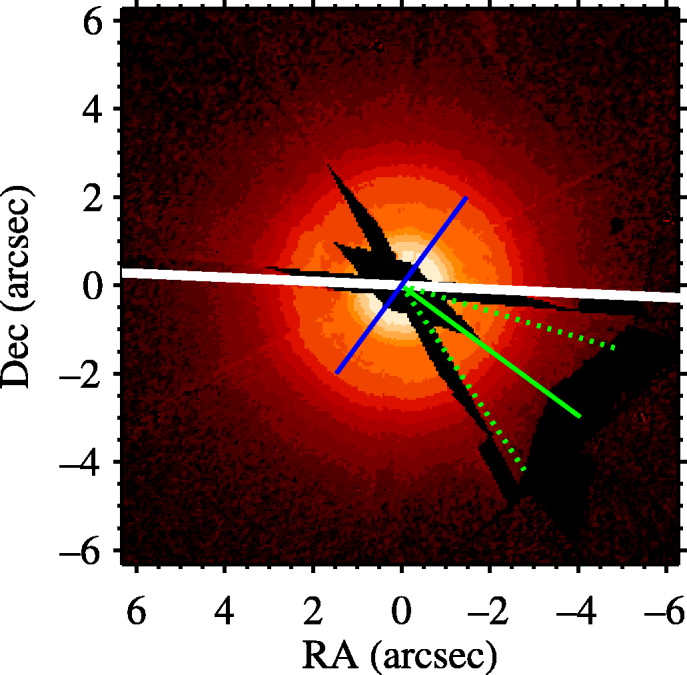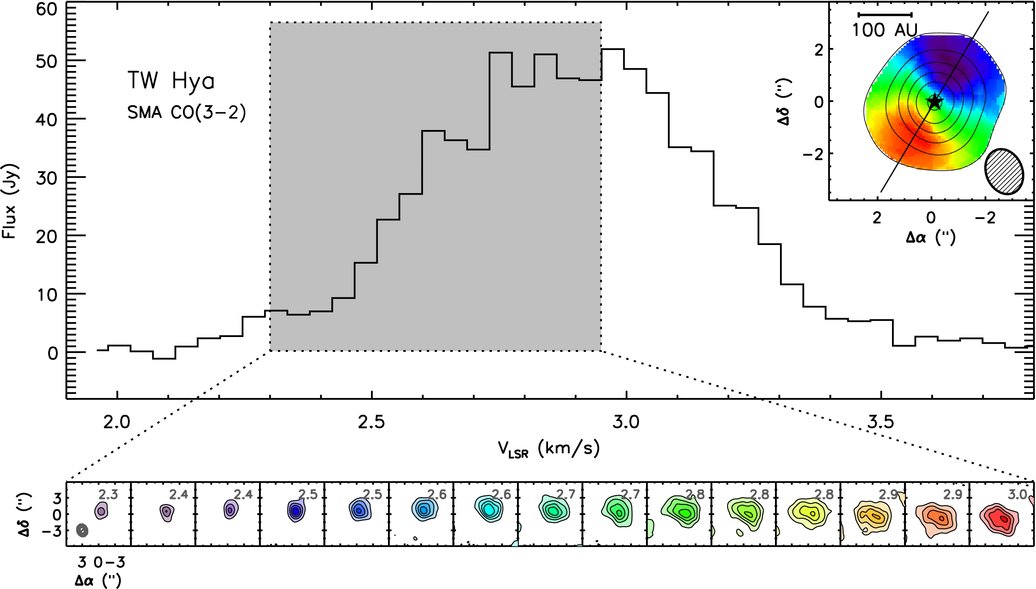TWHydraBand7 For CASA 3.3: Difference between revisions
| Line 20: | Line 20: | ||
HCO+(4-3) data has not previously been published, but SMA HCO+(3-2) data (at 267.55762 GHz) is presented in Qi et al. 2008 (ApJ, 681, 1396). These SMA data have comparable angular resolution but a wider 203 kHz channel width. | HCO+(4-3) data has not previously been published, but SMA HCO+(3-2) data (at 267.55762 GHz) is presented in Qi et al. 2008 (ApJ, 681, 1396). These SMA data have comparable angular resolution but a wider 203 kHz channel width. | ||
[[Image:TWHya_HCOp4_3_moments.png| | [[Image:TWHya_HCOp4_3_moments.png|left|600px]] ''ALMA HCO+(4-3) moment maps from TW Hya, with white continuum contours at 3 and 100 sigma. From left to right: integrated intensity, intensity weighted velocity field, intensity weighted velocity dispersion are shown.'' | ||
==Obtaining the Data== | ==Obtaining the Data== | ||
Revision as of 14:27, 26 May 2011
Science Target Overview

TW Hya is a pre-main sequence classical T Tauri star at a distance of about 52+/-1 pc (Mamajek 2005,2010). TW Hya is the most studied member of the TW Hydra association (TWA) of low mass stars. From a wide variety of previous observations from the infrared to submillimeter, TW Hya is known to have a small optically thin hot inner disk to radii < 4 AU, and a larger cold dust disk out to about 200 AU (see for example introduction by Vacca & Sandell 2011, and references therein). Recent optical interferometry finds that TW Hya also contains a hot optically thick disk on even smaller sizescales of ~0.5 AU, and suggests that the optically thin disk could be due to gas clearing by a planet (Akeson et al. 2011). TW Hya is still accreting from its disk at a rate of about (4-20) x 10^-10 Msun/year and most recently its spectral type, mass, and age have been estimated at M2.5V, 0.4 Msun, and 3 Myr (Vacca & Sandell 2011).
Millimeter and submillimeter observations of the continuum and spectral lines are particularly useful for tracing in the outer cold disk. Previous observations by the VLA at 7 mm (Wilner et al. 2000), ATCA at 3 mm (Wilner et al. 2003), and the SMA at 1.3, 0.87, and 0.45 mm (Qi et al. 2004, 2006, 2008 and Hughes et al. 2011) reveal Keplerian rotation in the disk and an inclination of about 7 degrees (i.e. almost face-on). Detailed studies of the dust continuum properties from this work suggests that there are centimeter sized particles within the cold protoplanetary disk.
ALMA Data Overview

ALMA Science Verification data at Band 7 (~345 GHz) was taken for TW Hya on April 22, 2011. A scheduling block of about 1.5 hours long was run three times in a row for a total of about 4.5 hours of observing time. Nine antennas were available during these runs, but one has to be flagged. All four available basebands were used, resulting in four spectral windows (spws) containing data. Two basebands were placed in the Lower Sideband (LSB) and two basebands in the Upper Sideband (USB). In the LSB the CO(3-2) line at a rest frequency of 345.79599 GHz is located in spw=2. In the USB the HCO+(4-3) line at a rest frequency of 356.7342 GHz is located in spw=0. The other two spectral windows do not contain detectable spectral lines and are used for continuum. Each spectral window is 0.5 GHz wide and the channel width is 122 kHz. Because the ALMA correlator was configured to apply Hanning smoothing of the signal in the time domain, the effective spectral resolution is about twice the channel width, which in this case is about 0.2 km/s.

The ALMA CO(3-2) data presented here is similar to the Submillimeter Array data presented in Hughes et al. 2011 (ApJ, 727, 85), though the SMA data have ~3 times smaller channel width at 50 kHz.
HCO+(4-3) data has not previously been published, but SMA HCO+(3-2) data (at 267.55762 GHz) is presented in Qi et al. 2008 (ApJ, 681, 1396). These SMA data have comparable angular resolution but a wider 203 kHz channel width.

ALMA HCO+(4-3) moment maps from TW Hya, with white continuum contours at 3 and 100 sigma. From left to right: integrated intensity, intensity weighted velocity field, intensity weighted velocity dispersion are shown.
Obtaining the Data
The data are located HERE. Inside there are three directories.
RawDataAndTablesForReduction
CalibratedData
ReferenceImages
The data reduction tutorial for these data has been split into calibration and imaging pages:
(1) TWHydraBand7_Calibration this page requires that you download the RawDataAndTablesForReduction directory
(2) TWHydraBand7_Imaging this page requires that have either used TWHydraBand7_Calibration to obtain the CalibratedData or that you have downloaded this directory.
Alternatively you can just download the final images (ReferenceImages directory).
NOTE: CASA 3.2.0 or later is required to process these data
How to Use A casaguide
For tips on using CASA and ways CASA can be run, see EVLA_Spectral_Line_Calibration_IRC+10216#How_to_Use_This_casaguide page.
In the guides
# In CASA
Regions of this color are CASA commands (or definitions) that need to be cut and
pasted in sequence. Wait until one command is finished before pasting another.
Tabs matter in python, make sure that commands that span more than one line and
"for" loops keep their spacing. Sometimes (especially "for" loops) you may need to
explicitly hit enter twice to get the command going.
Information in this color shows excerpts from the CASA Logger output
This color shows you background information about the data.